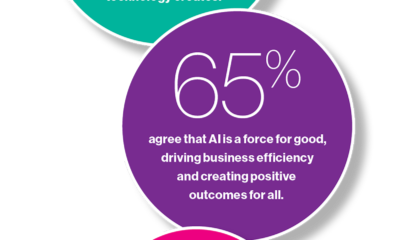Politics
The Human-AI Collaboration: Humans and Machines Can Work Together
Published
8 months agoon
By
Drew Simpson
In recent years, the pervasive influence of Artificial Intelligence (AI) has been transforming diverse facets of our lives at an accelerating pace. AI’s footprint is undeniable, from personalized recommendations on streaming platforms to autonomous vehicles navigating our roads. As we navigate this era of technological advancement, it becomes increasingly crucial to comprehend the profound potential that lies within the collaboration between humans and AI.
Understanding Human-AI Collaboration
Defining Collaboration and Its Significance
Human-AI collaboration refers to the strategic partnership between human intelligence and AI technology aimed at harnessing the unique strengths of both entities to achieve superior outcomes. This collaboration holds paramount significance due to its capacity to bridge the gap between human ingenuity and AI’s computational prowess. By blending humans’ cognitive capabilities with AI’s analytical power, we can aspire to solve complex problems and innovate in unprecedented ways.
Exploring Strengths and Limitations
Both humans and AI possess distinct capabilities that, when combined, create a synergy greater than the sum of its parts. Humans excel in creativity, empathy, and critical thinking—traits AI struggles to replicate authentically. On the other hand, AI thrives in data analysis, pattern recognition, and automation, areas that often challenge human capacity. It’s vital to recognize the limitations of each—human errors due to fatigue or cognitive bias, AI’s reliance on historical data, and the inability to comprehend emotions.
Highlighting Synergistic Potential
The fusion of human and AI strengths can lead to remarkable outcomes. For instance, consider medical diagnosis. While AI can rapidly analyze immense datasets to suggest potential diagnoses, human doctors bring nuanced judgment, empathy, and the ability to consider individual patient contexts. This combination can lead to accurate diagnoses and personalized treatment plans that enhance patient care. Similarly, in creative industries, AI can generate ideas and optimize processes, allowing humans to focus on refining and adding their unique touch.
Complementary Skill Sets
Human Cognitive Capabilities
Human cognition encompasses elements like creativity, empathy, and critical thinking. These qualities allow humans to navigate ambiguous situations, derive inspiration from diverse sources, and understand the emotional nuances underlying human interactions. This emotional intelligence enables effective communication, empathy-driven decision-making, and a deeper understanding of societal and cultural dynamics.
AI Strengths
AI’s strengths lie in its ability to process vast quantities of data quickly and accurately. With data analysis and pattern recognition, AI can identify trends and correlations that might elude human observation. Automation further streamlines tasks, freeing humans from repetitive chores and enabling them to focus on tasks requiring complex reasoning and adaptability.
Examples of Synergy
In customer service, AI-driven chatbots can swiftly address routine queries, leaving human agents to handle intricate issues that demand empathy and understanding. In financial analysis, AI can process market data and suggest potential investment opportunities, while human experts evaluate the broader economic context and make informed decisions.
As we explore the potential of human-AI collaboration, it’s evident that the interaction between human creativity and AI’s computational might yield more robust and innovative outcomes than either could achieve alone. This synergy is key to solving complex challenges, advancing technology, and redefining our collective potential.
Real-World Applications
Healthcare: Diagnosis, Treatment Planning, Medical Research
The integration of AI in healthcare has the potential to revolutionize patient care. AI-powered diagnostic tools can analyze medical images with exceptional precision, aiding doctors in detecting diseases at earlier stages. Treatment planning becomes more informed as AI analyzes patient data to recommend personalized therapies. In medical research, AI assists in sifting through massive datasets, identifying patterns, and accelerating drug discovery.
Business: Market Analysis, Customer Insights, Predictive Analytics
AI’s prowess in data analysis has transformed business strategies. Market analysis benefits from AI’s ability to process vast amounts of market data, unveiling trends, and potential opportunities. Customer insights become more nuanced as AI analyzes consumer behavior, aiding businesses in tailoring their offerings. Predictive analytics, driven by AI, allows businesses to anticipate market shifts and adapt proactively.
Creativity: Art Generation, Music Composition, Content Creation
AI’s role in creativity extends beyond data analysis. AI-generated art challenges conventional definitions of artistic creation. Music composition sees new dimensions as AI algorithms generate compositions ranging from classical to contemporary. Content creation benefits from AI’s ability to generate automated content, freeing creators to focus on refining and enhancing these creations.
Education: Personalized Learning, Automated Assessment, Skill Development
AI enables personalized learning experiences in education by adapting content to individual learning styles and paces. Automated assessment tools streamline grading, providing teachers more time for personalized instruction. AI-driven skill development platforms offer interactive learning experiences, helping learners acquire practical skills that align with industry needs.
Challenges and Considerations
Ethical Considerations in AI Utilization
The ethical dimension of AI deployment requires careful scrutiny. Decisions made by AI systems can impact lives and society. Ensuring that AI operates within ethical boundaries demands transparent decision-making processes and accountability mechanisms.
Addressing Biases and Ensuring Fairness in AI Algorithms
AI systems can inadvertently perpetuate biases present in training data. Efforts must be made to identify and rectify these biases, ensuring that AI-driven decisions are fair and unbiased, especially in sensitive domains like criminal justice and lending.
Striking the Balance Between Human Oversight and Automation
Balancing human judgment with automation is pivotal. While AI excels in specific tasks, human oversight remains essential to make context-aware decisions, particularly when dealing with complex, nuanced situations.
Potential Job Displacement and Reskilling Needs
The fear of AI-induced job displacement is a legitimate concern. To mitigate this, a focus on reskilling and upskilling becomes paramount. Preparing the workforce for evolving roles and equipping them with skills complementing AI-driven tasks can facilitate a smoother transition.
Enhancing Collaboration
Designing AI Interfaces for User-Friendliness and Usability
The effectiveness of human-AI collaboration hinges on intuitive interfaces. Designing AI systems with user-friendliness in mind simplifies interaction, making AI accessible to a broader range of users. Clear visual cues, natural language processing, and easy-to-navigate dashboards enhance the experience, enabling users to harness AI’s power without being technologically fluent.
Developing AI Systems That Learn from Human Feedback and Interaction
Creating AI systems that can adapt and improve over time is pivotal. AI models that incorporate human feedback continually refine their accuracy and relevance. This iterative process enhances performance and fosters a sense of partnership between humans and AI, where collaboration is geared towards mutual growth.
Promoting Interdisciplinary Education to Foster Collaboration
Nurturing collaboration between humans and AI requires a diverse skill set. Interdisciplinary education that bridges technological understanding with domain-specific expertise cultivates individuals capable of effectively communicating and collaborating with AI systems. This holistic approach creates a workforce that can extract the most value from AI solutions.
Future Prospects
Evolution of AI Technology and Its Implications for Human-AI Collaboration
As AI technology advances, its potential to integrate seamlessly with human activities continues to grow. The future promises deeper integration and transformative potential in various domains, from augmented reality-enhanced collaboration spaces to AI-augmented decision-making processes.
Speculating on New Fields and Industries, That Could Benefit from Collaboration
Industries beyond the familiar ones are poised to embrace the power of collaboration between humans and AI. Environmental conservation, urban planning, and interpersonal therapy could harness AI’s analytical capabilities and human empathy to address pressing global challenges.
Ethical Guidelines and Regulations for Responsible AI Integration
As human-AI collaboration expands, so does the need for ethical frameworks that guide its deployment. Governments, organizations, and technologists must collaborate to establish guidelines that ensure AI is wielded responsibly, upholding human rights, privacy, and fairness.
Conclusion
Recap of the Benefits and Challenges of Human-AI Collaboration
The journey of human-AI collaboration is marked by its potential to revolutionize industries and enhance human capabilities. However, challenges such as bias mitigation and job displacement warrant careful consideration.
Call to Action for Embracing and Shaping the Future of Collaborative AI
The path ahead requires proactive engagement with AI technology. Embracing its potential while remaining vigilant about its ethical implications will drive responsible and impactful integration.
Encouragement to Continue Exploring the Dynamic Relationship Between Humans and Machines
The relationship between humans and AI is dynamic and constantly evolving. Continuing to explore, experiment, and innovate in the realm of collaborative AI is essential to harness its full potential and shape a future where humans and machines truly complement one another.
In navigating the landscape of human-AI collaboration, we hold the power to shape a future where technology amplifies human potential and transforms industries for the better. The journey is ongoing, and by embracing it with foresight and responsibility, we can truly harness the revolutionary power of collaborative AI.
Featured Image Credit: Cottonbro Studios; Pexels; Thank you!
You may like
-


Augmenting the realities of work
-


Humans at the heart of generative AI
-


This startup wants to find out if humans can have babies in space
-


Minds of machines: The great AI consciousness conundrum
-


Elon Musk wants more bandwidth between people and machines. Do we need it?
-


Make Machine Learning Work for You
Politics
Fintech Kennek raises $12.5M seed round to digitize lending
Published
7 months agoon
10/11/2023By
Drew Simpson
London-based fintech startup Kennek has raised $12.5 million in seed funding to expand its lending operating system.
According to an Oct. 10 tech.eu report, the round was led by HV Capital and included participation from Dutch Founders Fund, AlbionVC, FFVC, Plug & Play Ventures, and Syndicate One. Kennek offers software-as-a-service tools to help non-bank lenders streamline their operations using open banking, open finance, and payments.
The platform aims to automate time-consuming manual tasks and consolidate fragmented data to simplify lending. Xavier De Pauw, founder of Kennek said:
“Until kennek, lenders had to devote countless hours to menial operational tasks and deal with jumbled and hard-coded data – which makes every other part of lending a headache. As former lenders ourselves, we lived and breathed these frustrations, and built kennek to make them a thing of the past.”
The company said the latest funding round was oversubscribed and closed quickly despite the challenging fundraising environment. The new capital will be used to expand Kennek’s engineering team and strengthen its market position in the UK while exploring expansion into other European markets. Barbod Namini, Partner at lead investor HV Capital, commented on the investment:
“Kennek has developed an ambitious and genuinely unique proposition which we think can be the foundation of the entire alternative lending space. […] It is a complicated market and a solution that brings together all information and stakeholders onto a single platform is highly compelling for both lenders & the ecosystem as a whole.”
The fintech lending space has grown rapidly in recent years, but many lenders still rely on legacy systems and manual processes that limit efficiency and scalability. Kennek aims to leverage open banking and data integration to provide lenders with a more streamlined, automated lending experience.
The seed funding will allow the London-based startup to continue developing its platform and expanding its team to meet demand from non-bank lenders looking to digitize operations. Kennek’s focus on the UK and Europe also comes amid rising adoption of open banking and open finance in the regions.
Featured Image Credit: Photo from Kennek.io; Thank you!
Radek Zielinski
Radek Zielinski is an experienced technology and financial journalist with a passion for cybersecurity and futurology.
Politics
Fortune 500’s race for generative AI breakthroughs
Published
7 months agoon
10/11/2023By
Drew Simpson
As excitement around generative AI grows, Fortune 500 companies, including Goldman Sachs, are carefully examining the possible applications of this technology. A recent survey of U.S. executives indicated that 60% believe generative AI will substantially impact their businesses in the long term. However, they anticipate a one to two-year timeframe before implementing their initial solutions. This optimism stems from the potential of generative AI to revolutionize various aspects of businesses, from enhancing customer experiences to optimizing internal processes. In the short term, companies will likely focus on pilot projects and experimentation, gradually integrating generative AI into their operations as they witness its positive influence on efficiency and profitability.
Goldman Sachs’ Cautious Approach to Implementing Generative AI
In a recent interview, Goldman Sachs CIO Marco Argenti revealed that the firm has not yet implemented any generative AI use cases. Instead, the company focuses on experimentation and setting high standards before adopting the technology. Argenti recognized the desire for outcomes in areas like developer and operational efficiency but emphasized ensuring precision before putting experimental AI use cases into production.
According to Argenti, striking the right balance between driving innovation and maintaining accuracy is crucial for successfully integrating generative AI within the firm. Goldman Sachs intends to continue exploring this emerging technology’s potential benefits and applications while diligently assessing risks to ensure it meets the company’s stringent quality standards.
One possible application for Goldman Sachs is in software development, where the company has observed a 20-40% productivity increase during its trials. The goal is for 1,000 developers to utilize generative AI tools by year’s end. However, Argenti emphasized that a well-defined expectation of return on investment is necessary before fully integrating generative AI into production.
To achieve this, the company plans to implement a systematic and strategic approach to adopting generative AI, ensuring that it complements and enhances the skills of its developers. Additionally, Goldman Sachs intends to evaluate the long-term impact of generative AI on their software development processes and the overall quality of the applications being developed.
Goldman Sachs’ approach to AI implementation goes beyond merely executing models. The firm has created a platform encompassing technical, legal, and compliance assessments to filter out improper content and keep track of all interactions. This comprehensive system ensures seamless integration of artificial intelligence in operations while adhering to regulatory standards and maintaining client confidentiality. Moreover, the platform continuously improves and adapts its algorithms, allowing Goldman Sachs to stay at the forefront of technology and offer its clients the most efficient and secure services.
Featured Image Credit: Photo by Google DeepMind; Pexels; Thank you!
Deanna Ritchie
Managing Editor at ReadWrite
Deanna is the Managing Editor at ReadWrite. Previously she worked as the Editor in Chief for Startup Grind and has over 20+ years of experience in content management and content development.
Politics
UK seizes web3 opportunity simplifying crypto regulations
Published
7 months agoon
10/10/2023By
Drew Simpson
As Web3 companies increasingly consider leaving the United States due to regulatory ambiguity, the United Kingdom must simplify its cryptocurrency regulations to attract these businesses. The conservative think tank Policy Exchange recently released a report detailing ten suggestions for improving Web3 regulation in the country. Among the recommendations are reducing liability for token holders in decentralized autonomous organizations (DAOs) and encouraging the Financial Conduct Authority (FCA) to adopt alternative Know Your Customer (KYC) methodologies, such as digital identities and blockchain analytics tools. These suggestions aim to position the UK as a hub for Web3 innovation and attract blockchain-based businesses looking for a more conducive regulatory environment.
Streamlining Cryptocurrency Regulations for Innovation
To make it easier for emerging Web3 companies to navigate existing legal frameworks and contribute to the UK’s digital economy growth, the government must streamline cryptocurrency regulations and adopt forward-looking approaches. By making the regulatory landscape clear and straightforward, the UK can create an environment that fosters innovation, growth, and competitiveness in the global fintech industry.
The Policy Exchange report also recommends not weakening self-hosted wallets or treating proof-of-stake (PoS) services as financial services. This approach aims to protect the fundamental principles of decentralization and user autonomy while strongly emphasizing security and regulatory compliance. By doing so, the UK can nurture an environment that encourages innovation and the continued growth of blockchain technology.
Despite recent strict measures by UK authorities, such as His Majesty’s Treasury and the FCA, toward the digital assets sector, the proposed changes in the Policy Exchange report strive to make the UK a more attractive location for Web3 enterprises. By adopting these suggestions, the UK can demonstrate its commitment to fostering innovation in the rapidly evolving blockchain and cryptocurrency industries while ensuring a robust and transparent regulatory environment.
The ongoing uncertainty surrounding cryptocurrency regulations in various countries has prompted Web3 companies to explore alternative jurisdictions with more precise legal frameworks. As the United States grapples with regulatory ambiguity, the United Kingdom can position itself as a hub for Web3 innovation by simplifying and streamlining its cryptocurrency regulations.
Featured Image Credit: Photo by Jonathan Borba; Pexels; Thank you!
Deanna Ritchie
Managing Editor at ReadWrite
Deanna is the Managing Editor at ReadWrite. Previously she worked as the Editor in Chief for Startup Grind and has over 20+ years of experience in content management and content development.
